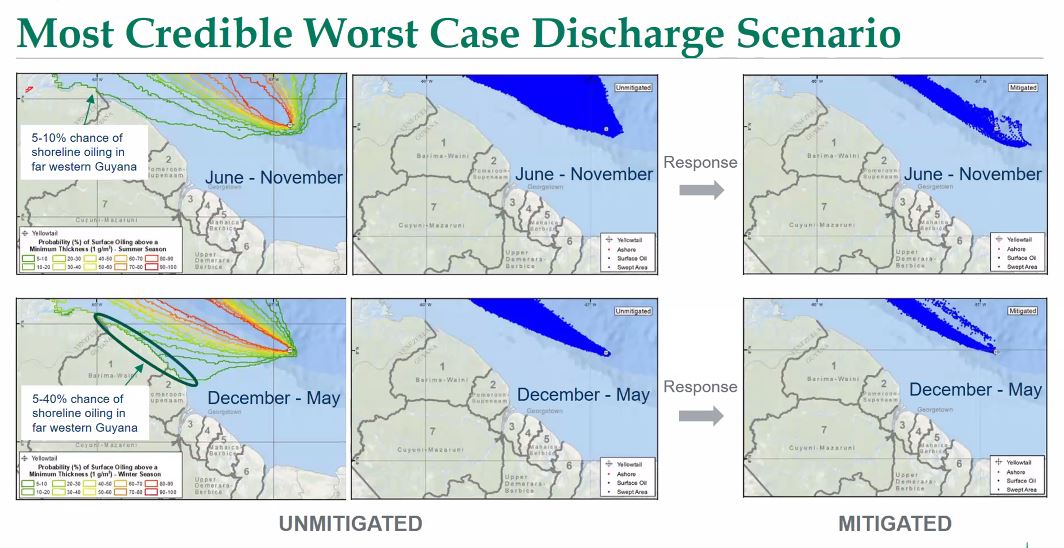EPA Head wants to be ‘comfortable’ with insurance for fourth oil project
By Vishani Ragobeer
Executive Director of the Environmental Protection Agency (EPA) Kemraj Parsram says that the agency wants to be “comfortable” that there is the necessary insurance in place to deal with an unplanned event, such as an oil spill, before it gives permission for ExxonMobil’s fourth development project called Yellowtail.
ExxonMobil is seeking environmental authorisation for the project which will actually extract oil from both the Yellowtail and Redtail fields in the giant Stabroek block where Exxon has so far made over 20 oil discoveries.
The start-up of the Yellowtail project is expected to begin in late 2025 and is anticipated to produce 220,000 barrels of oil per day from a Floating, Production, Storage and Offloading (FPSO) vessel that would be able to store up to two million barrels.
With this project, between 41 and 67 oil wells are expected to be drilled, and it will be on going at the same time as three other projects – Liza Phases One and Two and Payara.
“I am making sure that we are comfortable before we sign this document.
“… There is financial assurance stated in the Environmental Protection Act and that’s what we will follow,” Parsram stated at a recent online public consultation on the project.

At a recent public consultation on the environmental impact of the Yellowtail development, there were numerous questions about the financial assurances from the company to mitigate potential hazards, such as oil spills.
“If that happens, we will take responsibility and pay the legitimate costs,” Project Manager at ExxonMobil Steve Laws stated.
Laws explained that insurance is more of an “after-the-fact” recovery cost and consideration would be given to any incident, not just an oil spill.
The EPA Head, on the other hand, pointed out that insurance is a consideration before the project Is given approval.
According to Part VI of the Act, the EPA may require this “financial assurance” from the body seeking environmental authorisation for a project “for measures appropriate to prevent the adverse effects upon and following the cessation or closing of the works.”
Moreover, Section 31(2) states that the amount of financial assurance shall be specified and it may be provided, reduced or released in the stages specified in the environmental authorisation.
Parsram also stated that the EPA, the Ministry of Natural Resources and the Attorney-General’s Chamber are currently reviewing the draft agreement with EEPGL. As such, he explained that negotiations on considerations like insurance are still ongoing.
In the Environmental Impact Assessment (EIA) document submitted by EEPGL to the EPA for authorisation, mention was made of how the company would respond to an unplanned oil spill.

In that document, the company stated, inter alia, that it will be prepared by “… determining the financial liability and establishing claims and/or livelihoods remediation processes during a response.”
On questions of insurance garnered through consultations, the EIA stated that joint insurance coverage is obtained in the name of EEPGL and the other Stabroek block co-venturers for the “appropriate lines of coverage” depending on the project and scope of work.
“Specifically for the Yellowtail Project, the co-venturers have insurance coverage including Third Party Liability and the cost of regaining control of a well,” the document stated.
Insurance was mentioned 10 times in the more than 1,300 pages document but the size of the insurance was not stated.
Importantly, the EIA also illustrated several scenarios of the impact an unplanned oil spill might have. That includes the impact on several Caribbean countries, though it was emphasised that a large oil spill is “unlikely”.
And in the event of that “unlikely event” the EIA stated that EEPGL would establish a claims process and, depending on the magnitude of the oil spill, a livelihood remediation program.
The purpose of the claims process would be to provide compensation as appropriate for asset losses while the purpose of a livelihood remediation program would be to restore the
welfare and livelihoods of affected persons to conditions no less than pre-impact conditions.
Editor’s note: Statements made by the representative of ExxonMobil were initially attributed to Mr. Erik DeMicco by the News Room. It was later clarified that Mr. Steve Laws was using Mr. DeMicco’s Zoom account during the consultations and it was in fact, Mr Laws who made the statements.
The News Room apologises for any inconvenience caused.






